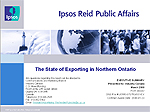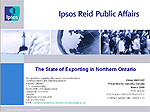Branch and Directorate
FedNor
Rationale
FedNor is an organization within Industry Canada which supports regional development in Northern Ontario through its delivery of the Northern Ontario Development Program (NODP) and the Community Futures (CF) Program. FedNor is currently examining the ways in which its programming could further support SMEs, specifically those with exportable goods and services, in Northern Ontario.
Anticipated Outcomes / Benefits
The data gathered through this research project will be analyzed with Statistics Canada — Exporter Registry data (2001-2006) in a broader study: The State of Exporting in Northern Ontario. The research project was designed to shed light on the exporting challenges facing Northern Ontario small and medium-sized enterprises (SMEs). [Note: SMEs are defined as businesses with 1 to 499 employees.]
Research Information
The interviews were conducted by telephone between February 7 and February 28, 2008, with 400 respondents who were identified through a combination of sources, including records provided by the Trade Commissioner Service of Canada, as well as private sector sample vendors.
The target audience consisted of senior managers of SMEs in Northern Ontario from industry sectors with exportable goods and services. It is important to understand the challenges of selling goods and services outside of Northern Ontario and why some companies choose not to export. Therefore, the survey was not limited to exporting companies or to those who plan to export. The Statistics Canada data was used to set the context of export activity in the region.
For the purposes of this research the term "export" was defined to mean "selling goods or services outside of Northern Ontario."
Northern Ontario was defined to include the Census Divisions of Muskoka, Nipissing, Parry Sound, Manitoulin, Sudbury, Sudbury Regional Municipality, Timiskaming, Cochrane, Algoma, Thunder Bay, Rainy River and Kenora.
Contracting:
Research Firm: Ipsos Reid
Contract #: DSS U7650-073753/001/CY
Contract issued by: PWGSC
Contract value: $48,872,80
The State of Exporting in Northern Ontario: Summary
The State of Exporting in Northern Ontario: Final Report
The State of Exporting in Northern Ontario: Summary
Ipsos Reid Public Affairs
Any questions regarding this report can be directed to:
Communications and Marketing Branch
Industry Canada
C.D. Howe Building
Room 204E, 235 Queen Street
Ottawa, Ontario K1A 0H5
Canada
Telephone: 343-291-3578
Fax: 613-952-5162
Email: janis.camelon@canada.ca
Executive Summary
Presented to: Industry Canada
March 2008
POR 348-07
DSS File # U7650-073753/001/CY
Contract Award Date: 2008-01-23
Background
- The growth of small business is a critical element of the future prosperity of the Northern Ontario economy. Exporting is a logical way for Northern Ontario businesses to expand sales and protect themselves from the risk of a downturn in any one particular market. Export is the provision of goods, services or knowledge across national or international boundaries. Northern Ontario SMEs offer a wide range of goods and services to the world's markets.
- The data gathered through this research project will be analyzed and used with Statistics Canada data (2001–2005) in a broader study on the state of exporting in Northern Ontario.
- FedNor is an organization within Industry Canada which supports regional development in Northern Ontario through its delivery of the Northern Ontario Development Program (NODP) and the Community Futures (CF) Program. FedNor is currently examining the ways in which its programming could further support SMEs, specifically those with exportable goods and services, in Northern Ontario.
Methodology
- This research was conducted by telephone between February 7 and February 28, 2008.
- 400 respondents were interviewed during this research. Respondents were identified through a combination of sources, including records provided by the Trade Commissioner Service of Canada as well as private sector sample vendors.
- The target audience consisted of decision makers within small and medium-sized businesses in Northern Ontario within several targeted industries which either export or plan to export goods or services. For the purposes of this research the term "export" was defined to mean "selling goods or services outside of Northern Ontario."
- Decision makers were defined as senior managers within their business.
- Small and medium-sized enterprises included businesses of 1 (self employed) up to 499 employees.
- Northern Ontario was defined to include the Census Divisions of Muskoka; Nipissing; Parry Sound; Manitoulin; Sudbury; Sudbury Regional Municipality; Timiskaming; Cochrane; Algoma; Thunder Bay; Rainy River; and Kenora.
Results and Conclusions
- During this research we found that the Northern Ontario businesses surveyed are actively engaged in the sales of products outside of Northern Ontario with more than half (51%) saying they do so now and nearly two in five (39%) saying they plan to do so in the future.
- Furthermore, the companies surveyed indicate that more than half of their sales come from outside Northern Ontario (54.7%) with most of that amount due to sales in the rest of Ontario (25.3%).
- More than three in four (77%) say that their business outside Northern Ontario is profitable, although more say it is somewhat profitable (58%) than that it is very profitable (19%).
- Business conditions for sales outside of Nothern Ontario are not necessarily better than overall business conditions in Northern Ontario.
- The proportion who say their sales outside of Northern Ontario are growing (50%) is about the same as the proportion who say that their overall business is growing (51%).
- The rate of growth reported for sales outside of Northern Ontario (33.2%) is slightly lower than overall business growth (35.7%).
- However, businesses that choose to export are more likely to report that their business is growing and also report a higher rate of growth than non-exporters.
- Those who export (58%) are more likely than those who do not export (43%) to report that their overall business is growing.
- Those who export report a higher rate of overall business growth (38.8%) than do businesses that do not export (31.4%)
- These findings suggest that while it may not be easier for Northern Ontario businesses to sell outside the region than to sell within it, the businesses that choose to do so are more apt to grow than those who do not because they are enlarging their market.
- Among several possible challenges to developing export business, those most often seen as very or somewhat challenging included:
- Transportation/insurance costs (69%)
- Obtaining assistance and incentives from government (61%)
- Understanding exporting procedures/paperwork (55%)
- Managerial time to deal with export issues (53%)
- Financial resources for exporting (51%)
The State of Exporting in Northern Ontario: Final Report
Ipsos Reid Public Affairs
Any questions regarding this report can be directed to:
Communications and Marketing Branch
Industry Canada
C.D. Howe Building
Room 204E, 235 Queen Street
Ottawa, Ontario K1A 0H5
Canada
Telephone: 343-291-3578
Fax: 613-952-5162
Email: janis.camelon@canada.ca
Final Report
Presented to: Industry Canada
March 2008
POR 348-07
DSS File # U7650-073753/001/CY
Contract Award Date: 2008-01-23
Outline
Background
Methodology
Results and Conclusions
Detailed Findings
Respondent and Business Characteristics
Background
- The growth of small business is a critical element of the future prosperity of the Northern Ontario economy. Exporting is a logical way for Northern Ontario businesses to expand sales and protect themselves from the risk of a downturn in any one particular market. Export is the provision of goods, services or knowledge across national or international boundaries. Northern Ontario SMEs offer a wide range of goods and services to the world's markets.
- The data gathered through this research project will be analyzed and used with Statistics Canada data (2001–2005) in a broader study on the state of exporting in Northern Ontario.
- FedNor is an organization within Industry Canada which supports regional development in Northern Ontario through its delivery of the Northern Ontario Development Program (NODP) and the Community Futures (CF) Program. FedNor is currently examining the ways in which its programming could further support SMEs, specifically those with exportable goods and services, in Northern Ontario.
Methodology
- This research was conducted by telephone between February 7 and February 28, 2008.
- 400 respondents were interviewed during this research. Respondents were identified through a combination of sources, including records provided by the Trade Commissioner Service of Canada as well as private sector sample vendors.
- The target audience consisted of decision makers within small and medium-sized businesses in Northern Ontario within several targeted industries which either export or plan to export goods or services. For the purposes of this research the term "export" was defined to mean "selling goods or services outside of Northern Ontario."
- Decision makers were defined as senior managers within their business.
- Small and medium-sized enterprises included businesses of 1 (self employed) up to 499 employees.
- Northern Ontario was defined to include the Census Divisions of Muskoka; Nipissing; Parry Sound; Manitoulin; Sudbury; Sudbury Regional Municipality; Timiskaming; Cochrane; Algoma; Thunder Bay; Rainy River; and Kenora.
- Several key industries were targeted to include businesses more likely to export goods and services. The targeted industries included businesses corresponding to the following NAICS descriptions:
- Mining and Mining Supply (212–213);
- Heavy and Civil Engineering Construction (237)
- Manufacturing (31–33);
- Wholesale Trade — Machinery, Equipment and Supplies (417)
- Professional Services (5413)
- Architectural, Engineering and related services (5414)
- Specialized Design Services (5415)
- Computer Systems Design and related services (5416)
- Management, Scientific and Technical Consulting Services (5417)
- Scientific Research and Development Services (810)
- Given the particular definition of the audience as indicated above, and the fact that the audience was not identified through an entirely random means of selection, this data is not intended to represent the views of Northern Ontario business decision makers in general, but rather of the specific segment of Northern Ontario businesses decision makers as described above.
- The following response rate analysis has been conducted according to the empirical calculation of the Marketing Research and Intelligence Association.
Empirical Calculation for Data Collection Total Numbers Attempted 1712 Invalid (NIS, fax/modem, business/non-res.) 239 Unresolved (U) (Busy, no answer, answering machine) 498 In-scope - non-responding (IS) 540 Language problem 5 Illness, incapable, deaf 131 Household refusal 78 Respondent refusal 278 Qualified respondent break-off 48 In-scope - Responding units (R) 435 Other disqualify 35 Completed interviews 400 Response Rate = R/(U+IS+R) 30%
Results and Conclusions
- During this research we found that the Northern Ontario businesses surveyed are actively engaged in the sales of products outside of Northern Ontario with more than half (51%) saying they do so now and nearly two in five (39%) saying they plan to do so in the future.
- Furthermore, the companies surveyed indicate that more than half of their sales come from outside Northern Ontario (54.7%) with most of that amount due to sales in the rest of Ontario (25.3%).
- More than three in four (77%) say that their business outside Northern Ontario is profitable, although more say it is somewhat profitable (58%) than that it is very profitable (19%).
- Business conditions for sales outside of Nothern Ontario are not necessarily better than overall business conditions in Northern Ontario.
- The proportion who say their sales outside of Northern Ontario are growing (50%) is about the same as the proportion who say that their overall business is growing (51%).
- The rate of growth reported for sales outside of Northern Ontario (33.2%) is slightly lower than overall business growth (35.7%).
- However, businesses that choose to export are more likely to report that their business is growing and also report a higher rate of growth than non-exporters.
- Those who export (58%) are more likely than those who do not export (43%) to report that their overall business is growing.
- Those who export report a higher rate of overall business growth(38.8%) than do businesses that do not export (31.4%)
- These findings suggest that while it may not be easier for Northern Ontario businesses to sell outside the region than to sell within it, the businesses that choose to do so are more apt to grow than those who do not because they are enlarging their market.
- Among several possible challenges to developing export business, those most often seen as very or somewhat challenging included:
- Transportation/insurance costs (69%)
- Obtaining assistance and incentives from government (61%)
- Understanding exporting procedures/paperwork (55%)
- Managerial time to deal with export issues (53%)
- Financial resources for exporting (51%)
Detailed Findings
Export Status
To begin with, which of the following best describes your business?
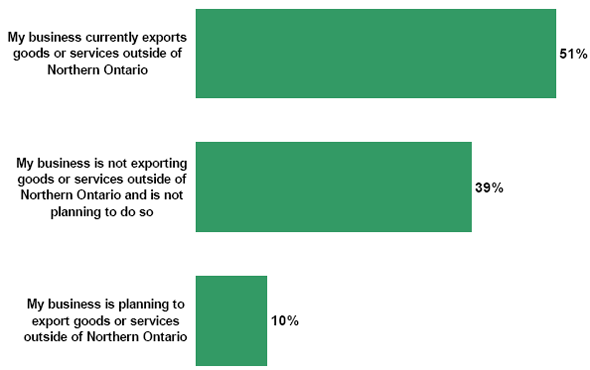
Base: All respondents n=400
Sale of Exportable Goods
Do you sell goods and services that could be exported?
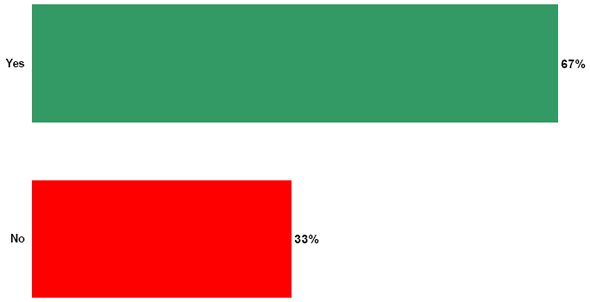
Base: Respondents planning to export or not exporting goods or services outside of Northern Ontario n=196
Reasons Preventing Business from Exporting Outside Northern Ontario
What would you say is preventing your business from exporting outside of Northern Ontario?
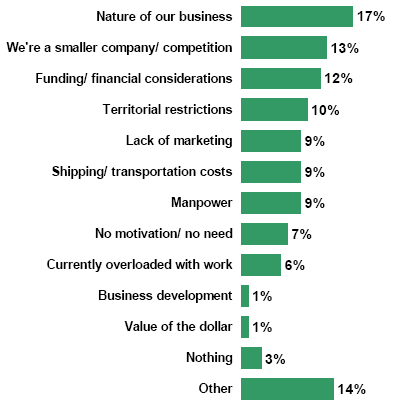
Base: Respondents planning to export or not exporting goods or services outside of Northern Ontario n=196
Percentage of Annual Sales from Regions Outside Northern Ontario
Approximately what percentage of your annual sales comes from the following regions. If you do not sell to the region, your answer is zero. If you don't know the exact number for a given region simply use your best estimate. What percentage of your annual sales comes from … ?
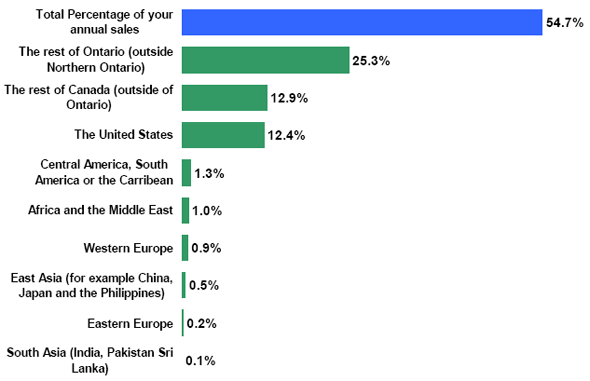
Base: Respondents who export goods or services outside of Northern Ontario n=204
Years Company has Exported Goods or Services Outside Northern Ontario
For how many years has your company exported goods or services outside Northern Ontario?
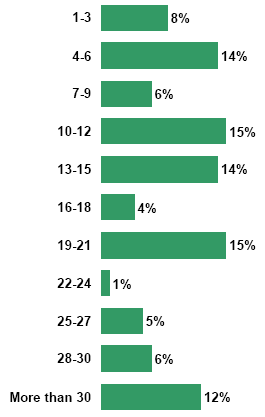
Base: Respondents who export goods or services outside of Northern Ontario n=204
Degree to Which Export Business is Profitable
Would you say that your export business is very profitable, somewhat profitable, breaking about even or losing money?
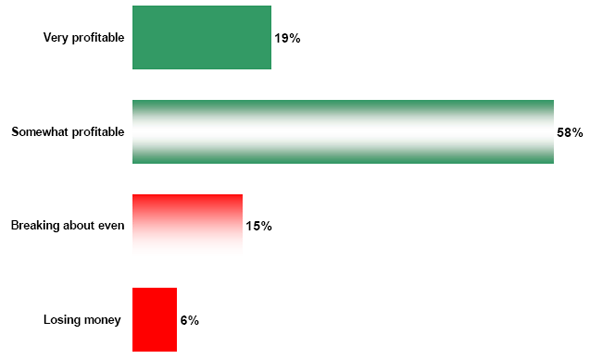
Base: Respondents who export goods or services outside of Northern Ontario n=204
Growth in Export Sales vs. Growth in Overall Business
Compared to earlier years do you find that your export sales outside of Northern Ontario are growing rapidly, growing slowly, declining slowly, declining rapidly or staying about the same?/ Compared to earlier years do you find that your business overall, including exports and domestic sales, is growing rapidly, growing slowly, declining slowly, declining rapidly or staying about the same?
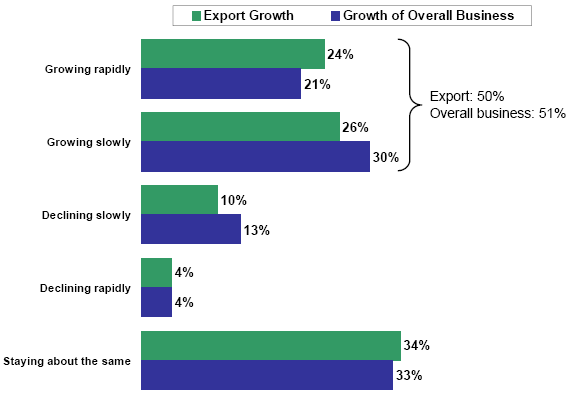
Base: Respondents who export goods or services outside of Northern Ontario n=204
Base: All Respondents n=400
Growth in Overall Business: Exporters vs. Non Exporters
Compared to earlier years do you find that your business overall, including exports and domestic sales, is growing rapidly, growing slowly, declining slowly, declining rapidly or staying about the same?

Base: Respondents who export goods or services outside of Northern Ontario n=204
Base: All Respondents n=400
Percentage by which Export Sales Have Grown vs. Sales Overall
Specifically, by what percentage would you say the export sales of your business have grown over the past three years?/ Specifically, by what percentage would you say the overall sales of your business, including sales inside and outside of Northern Ontario, have grown over the past three years?
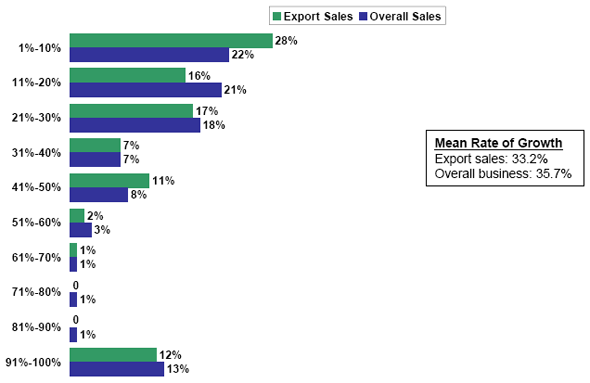
Base: Respondents who found that export sales outside of Northern Ontario have grown n=103
Base: Business overall has been growing n=202
Percentage Growth of Overall Business: Exporters vs. Non Exporters
Specifically, by what percentage would you say the overall sales of your business, including sales inside and outside of Northern Ontario, have grown over the past three years?
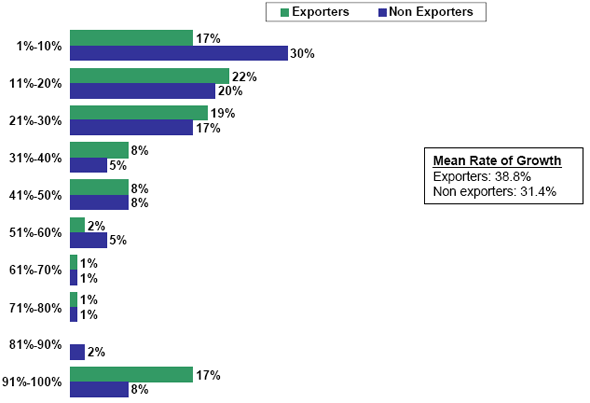
Base: Respondents who found that export sales outside of Northern Ontario have grown n=103
Base: Business overall has been growing n=202
Means of Conducting Export Business
Which of the following best reflects how your business currently conducts business in export markets?

Base: Respondents who export goods or services outside of Northern Ontario n=204
Biggest Challenges to Doing Business Outside Northern Ontario
What would you identify as the biggest challenges faced by Northern Ontario companies that wish to do business outside of Northern Ontario?
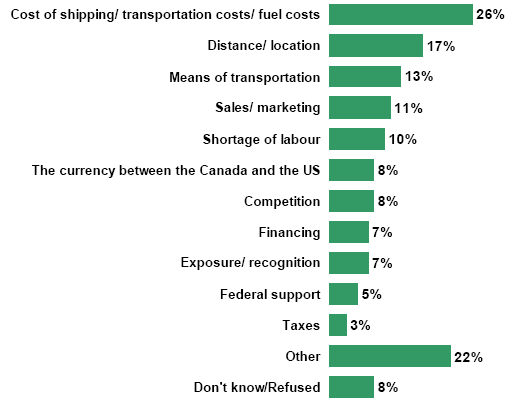
Mentions of 3% or higher
Base: All respondents n=400
Keys to Successfully Selling Goods and Services Outside of Northern Ontario
What do you consider to be the keys for businesses in Northern Ontario to successfully sell their goods and services outside of Northern Ontario?
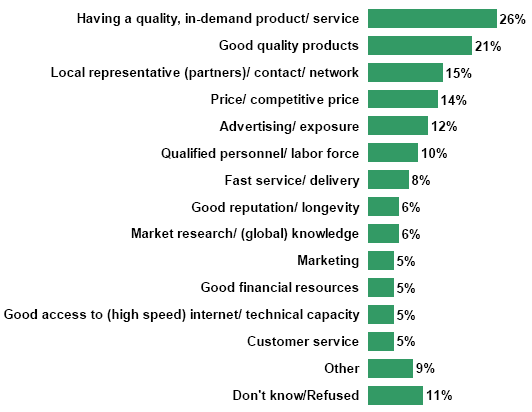
Base: All respondents n=400
Challenging Factors to Exporting Goods and Services
I will now read you a list of factors that might impact companies in Northern Ontario who export goods and services. I would like you to tell me how much of a challenge you consider each on a scale of 1 to 7 where 1 means not challenging and 7 means very challenging
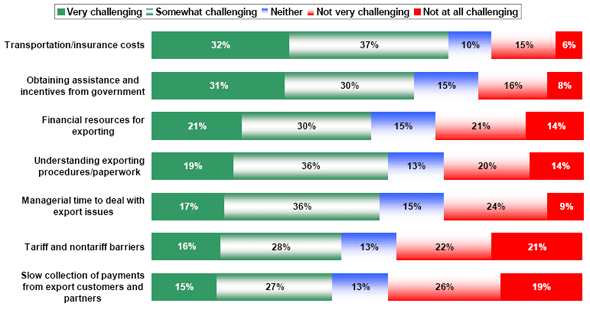
Base: All respondents n=400
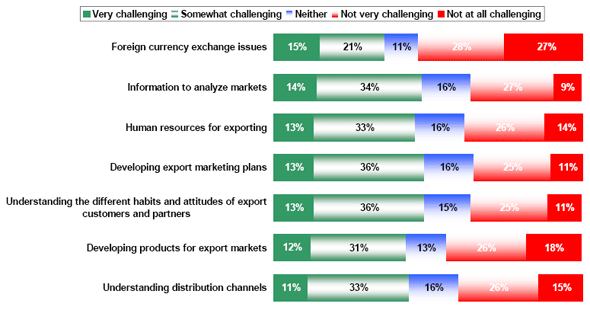
Base: All respondents n=400
Respondent and Business Characteristics
Role in Company
Which one of the following best describes the role you play in your company?
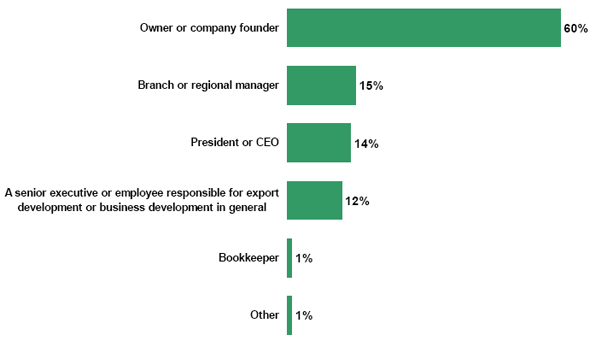
Base: All respondents n=400
Number of Employees in Business
Including yourself, how many employees does your business currently have, including both full-time and part-time people?
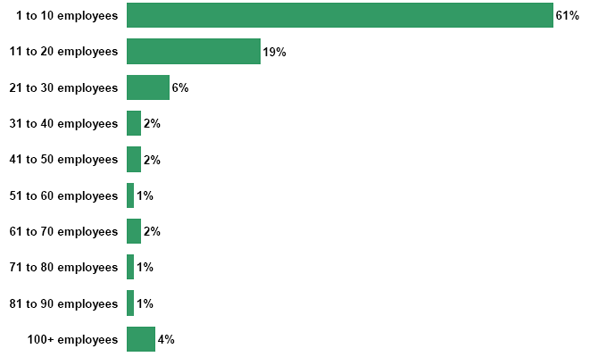
Base: All respondents n=400
Number of Employees Hired During Previous 12 Months
How many full or part time employees has your business hired during the previous 12 months?

Base: All respondents n=400
Annual Sales During Previous Fiscal Year
Approximately what were your company's annual sales in your last fiscal year?

Base: All respondents n=400
Years Company in Operation
How many years has your company been in operation?
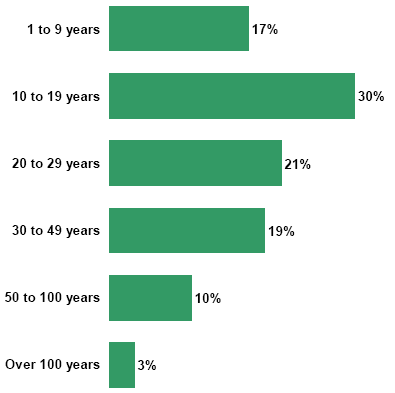
Base: All respondents n=400
Years in Current Position
How long have you been in your current position with your company?
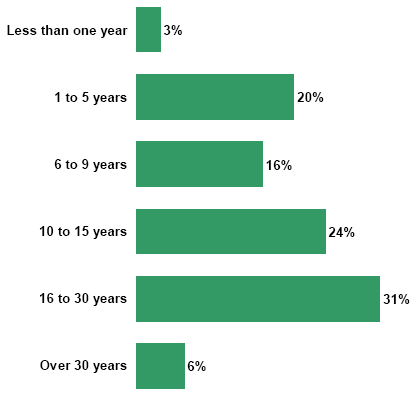
Base: All respondents n=400
Company's Main Business Line
Which of the following most closely reflects your company's main business line?
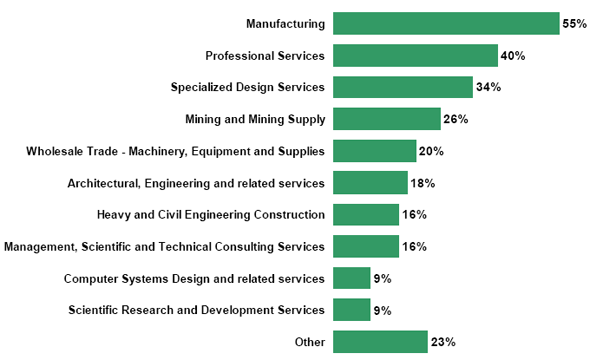
Base: All respondents n=400

